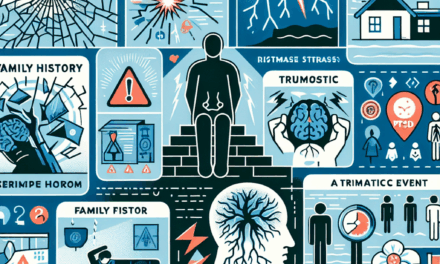Enhancing Well-Being and Productivity: How Digital Mental Health Can Combat Burnout
In today’s fast-paced world, burnout has become a prevalent issue affecting individuals across various sectors. The constant demands of work, coupled with personal responsibilities, can lead to emotional exhaustion, reduced performance, and a sense of detachment. As organizations and individuals seek effective solutions to combat burnout, digital mental health tools have emerged as a promising avenue. This article explores how these tools can enhance well-being and productivity, providing insights into their effectiveness, implementation, and future potential.
Understanding Burnout: Causes and Consequences
Burnout is a psychological syndrome that arises from prolonged and chronic stress, particularly in the workplace. It is characterized by three main dimensions: emotional exhaustion, depersonalization, and a reduced sense of personal accomplishment. Understanding the causes and consequences of burnout is crucial for developing effective interventions.
Causes of Burnout
Burnout can stem from various factors, including:
- Workload: Excessive workloads and unrealistic deadlines can overwhelm employees, leading to stress and burnout.
- Lack of Control: Employees who feel they have little control over their work processes or outcomes are more susceptible to burnout.
- Insufficient Rewards: A lack of recognition or rewards for hard work can diminish motivation and contribute to feelings of inadequacy.
- Poor Work-Life Balance: Difficulty in balancing professional and personal responsibilities can lead to chronic stress.
- Unclear Job Expectations: Ambiguity regarding job roles and responsibilities can create confusion and anxiety.
Consequences of Burnout
The consequences of burnout extend beyond the individual, affecting organizations and society as a whole. Some of the key consequences include:
- Decreased Productivity: Burnout leads to reduced efficiency and effectiveness in the workplace.
- Increased Absenteeism: Employees experiencing burnout are more likely to take sick leave, resulting in higher costs for organizations.
- Higher Turnover Rates: Burnout can drive employees to leave their jobs, leading to increased recruitment and training costs.
- Negative Impact on Mental Health: Chronic burnout can lead to anxiety, depression, and other mental health issues.
- Strained Relationships: Burnout can affect interpersonal relationships, both at work and at home.
Recognizing the causes and consequences of burnout is the first step toward implementing effective solutions. Digital mental health tools can play a significant role in addressing these issues.
The Rise of Digital Mental Health Solutions
Digital mental health solutions encompass a wide range of tools and platforms designed to support mental well-being. These include mobile applications, online therapy platforms, and virtual support groups. The rise of these solutions can be attributed to several factors:
Accessibility and Convenience
One of the most significant advantages of digital mental health solutions is their accessibility. Individuals can access resources and support from the comfort of their homes, eliminating barriers such as transportation and scheduling conflicts. This convenience is particularly beneficial for those who may feel stigmatized seeking help in traditional settings.
Cost-Effectiveness
Digital mental health tools often come at a lower cost compared to traditional therapy. Many apps offer free or low-cost resources, making mental health support more accessible to a broader audience. This cost-effectiveness can encourage individuals to seek help before their issues escalate into more severe problems.
Personalization and Customization
Many digital mental health solutions utilize algorithms to provide personalized recommendations based on user input. This customization allows individuals to engage with content that resonates with their specific needs and preferences, enhancing the effectiveness of the intervention.
Data-Driven Insights
Digital platforms can collect and analyze user data to provide insights into mental health trends and outcomes. This data can be invaluable for researchers and practitioners seeking to understand the effectiveness of various interventions and improve future offerings.
Integration with Existing Systems
Digital mental health solutions can be integrated into existing workplace wellness programs, enhancing their effectiveness. Organizations can leverage these tools to provide employees with additional resources and support, creating a more comprehensive approach to mental health.
The rise of digital mental health solutions presents a unique opportunity to combat burnout and enhance overall well-being. However, it is essential to understand how these tools can be effectively implemented in various settings.
Implementing Digital Mental Health Tools in the Workplace
To effectively combat burnout, organizations must strategically implement digital mental health tools. This process involves several key steps:
Assessing Employee Needs
Before implementing any digital mental health solution, organizations should assess the specific needs of their employees. This can be done through surveys, focus groups, or one-on-one interviews. Understanding the unique challenges faced by employees will help organizations select the most appropriate tools.
Choosing the Right Tools
With a plethora of digital mental health solutions available, organizations must carefully evaluate their options. Factors to consider include:
- User-Friendliness: The chosen tools should be easy to navigate and use.
- Evidence-Based Approaches: Look for tools that are backed by research and have demonstrated effectiveness.
- Integration Capabilities: Ensure that the tools can be integrated with existing systems and programs.
- Privacy and Security: Protecting employee data is paramount; choose tools that prioritize confidentiality.
Promoting Awareness and Engagement
Once the tools are selected, organizations must promote awareness and encourage employee engagement. This can be achieved through:
- Training Sessions: Offer training to familiarize employees with the tools and their benefits.
- Incentives: Consider providing incentives for employees who actively engage with the tools.
- Regular Communication: Keep employees informed about new features and updates to the tools.
Monitoring and Evaluating Effectiveness
To ensure the success of digital mental health initiatives, organizations should continuously monitor and evaluate their effectiveness. This can involve:
- Collecting Feedback: Regularly solicit feedback from employees regarding their experiences with the tools.
- Analyzing Usage Data: Review data on how frequently employees are using the tools and which features are most popular.
- Measuring Outcomes: Assess changes in employee well-being and productivity over time.
Creating a Supportive Culture
Finally, organizations must foster a culture that prioritizes mental health. This involves:
- Leadership Support: Leaders should model healthy behaviors and openly discuss mental health.
- Encouraging Open Dialogue: Create an environment where employees feel comfortable discussing their mental health challenges.
- Providing Additional Resources: Offer a variety of resources, including workshops, counseling services, and peer support groups.
By implementing digital mental health tools thoughtfully and strategically, organizations can create a supportive environment that combats burnout and enhances employee well-being.
Case Studies: Successful Implementation of Digital Mental Health Tools
Examining real-world examples of organizations that have successfully implemented digital mental health tools can provide valuable insights into best practices and potential outcomes. Here are a few notable case studies:
Case Study 1: A Tech Company’s Mental Health Initiative
A leading tech company recognized the rising levels of burnout among its employees and decided to implement a digital mental health platform. The company conducted an employee survey to assess mental health needs and selected a comprehensive app that offered resources such as mindfulness exercises, virtual therapy sessions, and peer support groups.
To promote engagement, the company organized training sessions and provided incentives for employees who used the app regularly. Over six months, the company monitored usage data and collected feedback from employees. The results were promising: 70% of employees reported feeling less stressed, and productivity levels increased by 15%.
Case Study 2: A Healthcare Organization’s Approach
A healthcare organization faced high levels of burnout among its staff due to the demanding nature of their work. To address this issue, the organization implemented a digital mental health platform that included access to licensed therapists and wellness resources.
The organization encouraged employees to utilize the platform by integrating it into their existing wellness program. They also provided regular workshops on stress management and resilience. After one year, the organization reported a 30% decrease in turnover rates and improved employee satisfaction scores.
Case Study 3: A Nonprofit’s Innovative Solution
A nonprofit organization serving vulnerable populations recognized the importance of mental health for its employees. They implemented a digital mental health tool that offered anonymous support and resources tailored to the unique challenges faced by nonprofit workers.
The organization promoted the tool through regular communication and created a peer support network to encourage usage. After six months, they found that employees who engaged with the tool reported higher levels of job satisfaction and a greater sense of community within the organization.
These case studies illustrate the potential benefits of implementing digital mental health tools in various organizational contexts. By learning from these examples, other organizations can develop effective strategies to combat burnout and enhance employee well-being.
The Future of Digital Mental Health Solutions
The future of digital mental health solutions looks promising, with advancements in technology and an increasing focus on mental well-being. Several trends are shaping the landscape of digital mental health:
Integration of Artificial Intelligence
Artificial intelligence (AI) is poised to revolutionize digital mental health solutions. AI can analyze user data to provide personalized recommendations and interventions, enhancing the effectiveness of these tools. For example, AI-driven chatbots can offer immediate support and resources based on user input, making mental health assistance more accessible.
Expansion of Teletherapy
The COVID-19 pandemic accelerated the adoption of teletherapy, and this trend is likely to continue. As more individuals become comfortable with virtual therapy sessions, organizations can leverage teletherapy as a valuable resource for employees experiencing burnout.
Focus on Preventative Measures
Future digital mental health solutions will likely emphasize preventative measures rather than solely reactive approaches. Tools that promote resilience, stress management, and self-care will become increasingly important in combating burnout before it escalates.
Increased Collaboration with Employers
As organizations recognize the importance of mental health, there will be greater collaboration between digital mental health providers and employers. This partnership can lead to tailored solutions that address specific workplace challenges and promote a culture of well-being.
Emphasis on Data Privacy and Security
As digital mental health solutions become more prevalent, concerns about data privacy and security will continue to grow. Providers will need to prioritize confidentiality and implement robust security measures to protect user information.
The future of digital mental health solutions holds great potential for enhancing well-being and productivity. By embracing these advancements, organizations can create supportive environments that combat burnout and promote mental health.
Conclusion: A Path Forward for Well-Being and Productivity
Burnout is a significant challenge in today’s work environment, but digital mental health solutions offer a promising path forward. By understanding the causes and consequences of burnout, organizations can implement effective strategies to support employee well-being. The rise of digital mental health tools provides accessible, cost-effective, and personalized resources that can enhance mental health support.
Successful implementation requires careful assessment of employee needs, thoughtful selection of tools, and ongoing evaluation of effectiveness. Case studies demonstrate the potential benefits of these solutions, highlighting improved employee satisfaction and productivity.
As we look to the future, advancements in technology, increased collaboration between employers and providers, and a focus on preventative measures will shape the landscape of digital mental health. By prioritizing mental health and well-being, organizations can create healthier workplaces that foster resilience, engagement, and productivity.
In conclusion, embracing digital mental health solutions is not just a trend; it is a necessary step toward combating burnout and enhancing overall well-being in the workplace. Organizations that invest in these tools will not only support their employees but also cultivate a thriving, productive workforce.





